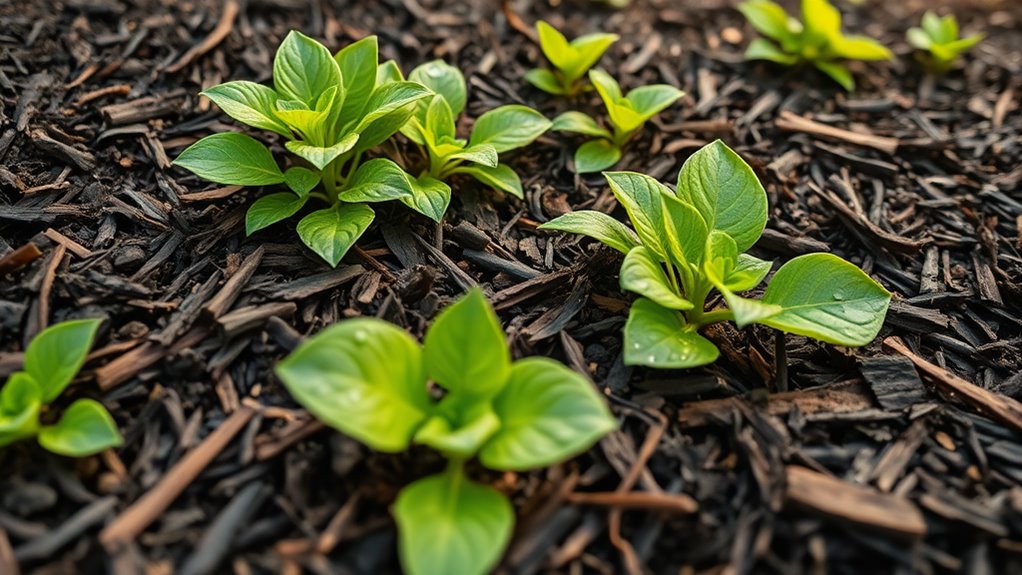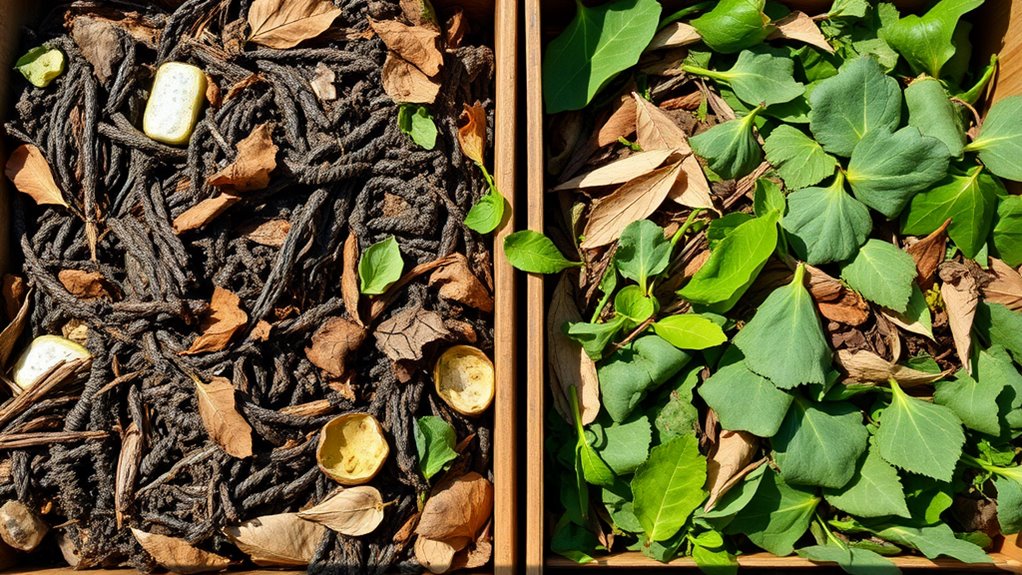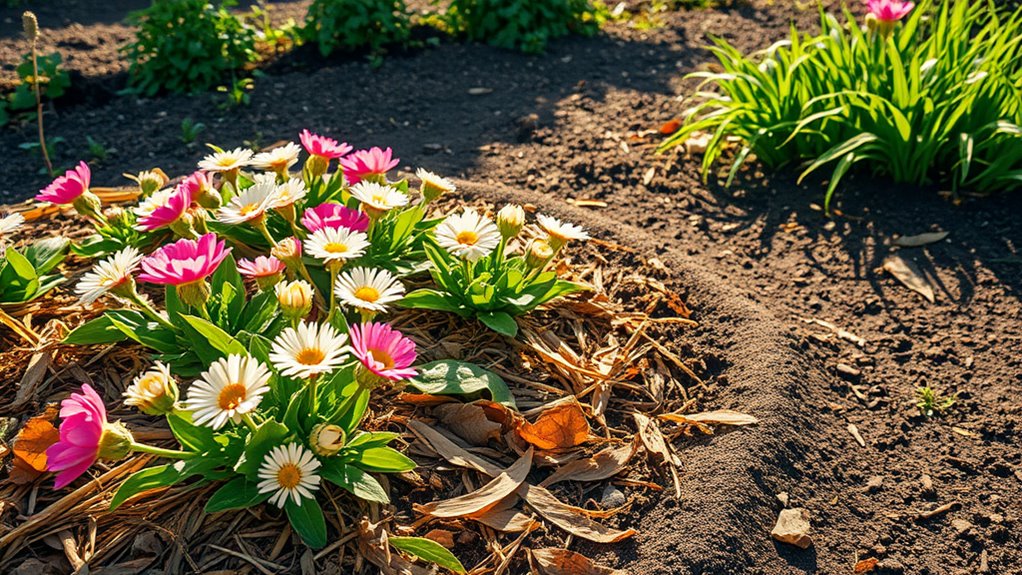The One Mulch Trick That Keeps My Garden Moist and Healthy
You’ve got a game-changer for your garden: apply 2-4 inches of organic mulch evenly around your plants. It locks in soil moisture by shading the ground and reducing evaporation, while suppressing weeds and enriching nutrients as it decomposes. You’ll notice healthier roots and less watering hassle. Keep going to uncover step-by-step tips and strategies for lasting garden success.
Key Takeaways
- Apply a 2-4 inch layer of organic mulch to effectively retain soil moisture and suppress evaporation.
- Clear weeds and debris from the garden bed before mulching to ensure optimal adhesion and weed control.
- Lightly water the soil prior to mulching for better mulch integration and enhanced moisture retention.
- Use a rake to spread mulch evenly, shading the soil and moderating temperature for healthier plant roots.
- Replenish mulch every few months to maintain its barrier against moisture loss and support long-term garden health.
The Secret Mulch Technique Revealed
Have you ever wondered how a simple mulch application can boost your garden’s health?
Mulching secrets lie in its ability to retain soil moisture and suppress weeds effectively. Scientifically, organic mulches like wood chips decompose, enriching the soil with nutrients and fostering beneficial microbes. This mulching technique ensures your garden stays consistently moist throughout the growing season.
You’ll notice improved soil structure as mulch moderates temperature fluctuations, reducing plant stress. Practically, it prevents erosion while promoting root growth, making your garden more resilient.
By harnessing these mulching secrets, you’re enhancing biodiversity and sustainability without unnecessary chemicals. Moreover, this technique supports pest control by creating a barrier that discourages harmful insects.
Stay tuned for deeper insights into this technique.
Step-by-Step Application Guide
Now that you’ve uncovered the benefits of mulching, it’s time to apply it effectively. First, clear your garden bed of weeds and debris to create a clean base.
Next, water the soil lightly for better adhesion. Choose organic mulch like bark or straw, then spread it evenly to a depth of 2-4 inches, avoiding direct contact with plant stems to prevent rot.
Use a rake to smooth the surface, ensuring uniform coverage. Monitor and replenish as needed, adjusting for seasonal changes to maintain optimal results.
This method promotes a healthy garden ecosystem. By incorporating various mulch types, you can transform your garden’s growth and overall size for better plant health.
Additionally, fall mulching enhances soil health and protects plants from harsh winter weather.
Benefits for Soil Moisture Retention
One of the primary benefits of mulching is that it significantly reduces soil moisture loss by creating a protective barrier. Additionally, avoiding soil prep mistakes can further enhance moisture retention by ensuring the soil is properly prepared beforehand.
This layer shades your soil from the sun, minimizing evaporation and helping you maintain consistent hydration levels even during dry spells.
Scientifically, mulch insulates the ground, moderating temperature fluctuations that can accelerate water loss.
As a result, you’ll find your plants thrive with less frequent watering, promoting efficient water use and preventing soil compaction.
In practice, this means healthier roots and a more resilient garden ecosystem focused solely on moisture retention.
Moreover, mulching serves as one of the no-cost methods for improving soil quality using natural techniques and materials from your own backyard.
Tips for Optimal Garden Health
While maintaining optimal garden health requires a balanced approach, start by selecting the right mulch type to suit your soil and plants, as this directly influences nutrient availability and pest resistance. You can boost vitality by applying mulch evenly and testing soil nutrients regularly—aim for a pH of 6.0-7.0 for optimal uptake. Monitor for pests and adjust mulch depth to 2-4 inches for best results. To further enhance pest resistance, consider implementing natural pest control methods that utilize unconventional remedies for effective results without harsh chemicals.
| Mulch Type | Key Benefits |
|---|---|
| Organic | Boosts microbial activity |
| Inorganic | Minimizes evaporation loss |
| Compost | Enhances nutrient cycling |
This strategy helps you maintain a thriving, balanced garden ecosystem. Additionally, integrating eco-friendly weed control methods can effectively reduce weed growth without harming your garden’s ecosystem.
Long-Term Maintenance Strategies
To sustain your garden’s health beyond initial tips, focus on long-term strategies that integrate regular monitoring and adaptive practices.
Check your mulch layer every few months; replenish it when it thins to maintain optimal depth, typically 2-4 inches, for effective moisture retention.
Monitor soil moisture with a simple probe, adjusting applications based on weather patterns to prevent overwatering or drought stress.
Scientifically, this fosters beneficial microbial activity, reducing erosion and nutrient loss.
Rotate mulch types seasonally—use organic ones like bark for sustained decomposition—and observe plant responses to fine-tune your approach for enduring vitality.
Additionally, to enhance moisture retention, incorporate expert watering techniques that address common pitfalls in plant hydration for overall garden vitality.
To optimize these strategies, start with proper soil preparation techniques that adapt to various environmental conditions for better overall plant health.





